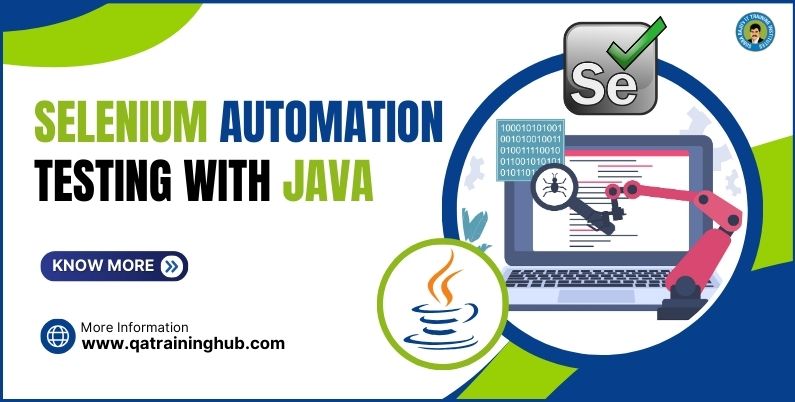
Mastering Selenium Automation Testing With Java: A Comprehensive Guide
In the software development, ensuring the quality of your application is important. Automated testing has become a crucial aspect of the development lifecycle, providing a way to quickly and effectively verify that your application performs as expected. Among the many tools available for automation testing, Selenium stands out as a powerful and available choice, particularly when combined with the Java programming language. This article discusses about Selenium Automation Testing with Java, exploring its benefits, key components, best practices, and advanced techniques.
Understanding Selenium Automation Testing
Selenium is an automation testing tool widely used for web application testing. It provides a set of tools and libraries that allow testers to automate web browsers across different platforms. Selenium WebDriver, in particular, allows interaction with web elements, navigation, and validation of web pages. Java, being a versatile and widely-used programming language, serves as an excellent companion to Selenium, providing stability, scalability, and extensive libraries for building automation frameworks.
Why Choose Selenium with Java?
Platform Independence: One of the most significant advantages of using Selenium with Java is its platform independence. Java runs on multiple operating systems, making it suitable for testing web applications across various fields smoothly.
Strong Community Support: Both Selenium and Java boast strong communities of developers and testers. This ensures continuous updates, bug fixes, and a vast repository of resources, tutorials, and documentation to aid in your automation journey.
Rich Ecosystem: Java’s rich ecosystem provides access to various libraries and frameworks that complement Selenium’s functionalities. This allows for the development of sophisticated automation frameworks tailored to specific project requirements.
Scalability and Maintainability: Java’s object-oriented nature promotes code reusability, scalability, and maintainability. Test automation projects built with Selenium and Java are easier to maintain and scale as the application grows and changes.
Integration Capabilities: Java’s smooth integration with other tools and technologies further improves Selenium’s capabilities. Integrating with build tools, version control systems, and Continuous Integration/Continuous Deployment (CI/CD) pipelines is straightforward with Java.
Key Components of Selenium Automation Testing with Java
Selenium WebDriver: Selenium WebDriver is the primary component which is responsible for automating web browsers. With Java bindings, WebDriver enables testers to interact with web elements, simulate user actions, and perform various validations.
TestNG: TestNG is a testing framework for Java inspired by JUnit and NUnit. It provides annotations, assertions, and reporting capabilities that reorganize the test development and execution process. TestNG smoothly integrates with Selenium, providing features such as parallel test execution, data-driven testing, and test prioritization.
Page Object Model (POM): The Page Object Model is a design pattern which is used to create an deposit layer between test scripts and web elements. In Selenium automation testing with Java, POM promotes code reusability, maintainability, and readability by capturing web page elements and their corresponding actions into separate classes.
WebDriverManager: WebDriverManager is a Java library that simplifies the management of WebDriver binaries. Instead of manually downloading and configuring WebDriver executables for various browsers, WebDriverManager dynamically makes the suitable drivers at runtime, allowing compatibility and easy setup.
Logging and Reporting: Logging and reporting are essential aspects of automation testing for analyzing test execution, identifying failures, and generating useful points. Java provides logging frameworks like Log4j and reporting libraries like ExtentReports, which can be smoothly combined into Selenium automation projects to improve visibility and accountability.
Best Practices for Selenium Automation Testing with Java
Maintain Clean and Modular Code: Follow best practices of object-oriented programming (OOP) to write clear, modular, and reusable code. Implement design patterns such as Page Object Model (POM) to separate page functionalities from test scripts, improving code maintainability and readability.
Use Explicit Waits: Stop hard-coded waits in test scripts, as they can lead to flakiness and inefficiency. Instead, Use explicit waits provided by Selenium WebDriver to wait for specific conditions to be met before proceeding with the test execution. This ensures synchronization between test steps and web elements, resulting in more dependable tests.
Parameterize Test Data: Parameterizing test data allows for the execution of the same test case with different input values. Utilize TestNG’s data provider feature or external data sources like Excel or CSV files to parameterize test data, making tests more quickly and easily.
Implement Cross-Browser Testing: Ensure compatibility and consistency across different web browsers by performing cross-browser testing. Selenium WebDriver supports various browsers , allowing testers to validate application functionality across various platforms.
Integrate with CI/CD Pipelines: Include Selenium automation tests into Continuous Integration/Continuous Deployment (CI/CD) pipelines to achieve faster feedback loops and ensure the quality of each code commit. Tools like Jenkins, Bamboo, or GitLab CI combined with Selenium and Java, allowing automated test execution as part of the CI/CD process.
Advanced Techniques
To Utilize the full potential of Selenium with Java, consider including advanced techniques:
Data-Driven Testing: Use data-driven testing to run the same test case with different sets of data. This approach improves test coverage and efficiency.
Parallel Testing: Implement parallel testing using Selenium Grid or a test framework to run tests simultaneously on multiple browsers and environments.
Continuous Integration (CI): Integrate Selenium tests with CI tools like Jenkins to automate the execution of tests as part of the build process.
Future Trends in Selenium Automation
The New ways of automation testing is constantly changing. Here are some emerging trends to watch for in Selenium automation:
AI and Machine Learning: Integrating AI and machine learning can improve test script generation, maintenance, and execution.
Codeless Automation: Tools that provide codeless automation are gaining traction, making it easier for non-developers to create and manage tests.
Increased Focus on Mobile Testing: With the growing importance of mobile applications, Selenium’s capabilities are expanding to better support mobile testing through tools like Appium.
Enhanced Cloud Testing: Cloud-based testing solutions are becoming more popular, providing scalable and cost-effective testing environments.
Conclusion
At QA Training Hub, we are here to empowering aspiring and experienced QA professionals with the knowledge and skills needed to succeed in automation testing. Our comprehensive courses focus on practical, real-world applications of automation tools and frameworks.
Selenium Automation Testing with Java provides a powerful combination for ensuring the quality and dependability of web applications. By using the features and capabilities of Selenium WebDriver, TestNG, and Java, testers can build strong automation frameworks that reorganize the testing process, improve efficiency, and enhance the overall quality of software products. With a strong emphasis on best practices, integration, and scalability, Selenium Automation Testing with Java continues to be a preferred choice for organizations striving to deliver high-quality web applications in today’s dynamic digital environment.
Join us at QA Training Hub to master Selenium Automation Testing with Java and take your career to new heights. Our expert-led training programs are here to equip you with the skills needed to tackle real-world challenges and drive success in your testing efforts.

